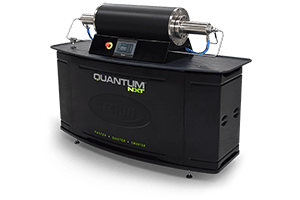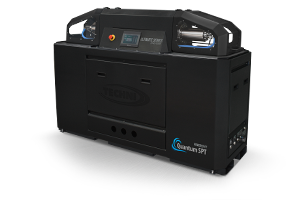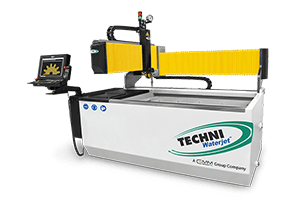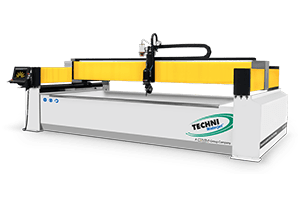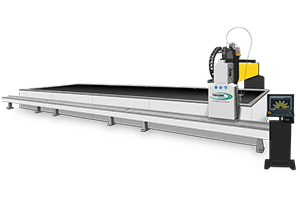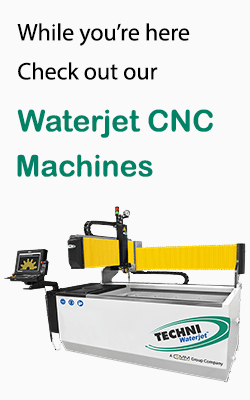What makes waterjet cutting truly remarkable is its ability to deliver incredibly precise cuts without the heat stress that other methods introduce.
The waterjet technology is a clean and incredibly versatile way to shape everything from industrial metals to delicate glass. Imagine a tool so powerful it uses nothing but water and a little grit to carve with the precision of a surgeon’s scalpel, all without the heat damage.
We’ll break down the complex language of waterjet cutting and explore key techniques that can transform the way you work.
Cutting Process and Techniques
Each aspect of waterjet technology is designed to meet diverse industrial needs, hence why there are different techniques, and they all ensure precision and efficiency. Here are the key processes and techniques you will encounter:
- Abrasive Blasting: Often used as a preparation technique, abrasive blasting cleans surfaces by forcefully projecting abrasive material to smooth or shape a surface, setting the stage for more precise waterjet cutting.
- Abrasive Waterjet: This method enhances cutting capabilities by adding an abrasive to the high-pressure water stream, making it suitable for tougher materials like metal and stone.
- Cold Cutting: Unlike traditional methods that generate heat, cold cutting uses waterjets to cut materials without altering their intrinsic properties, ideal for materials sensitive to high temperatures.
- Contour Cutting: Waterjet technology excels in contour cutting, allowing for intricate cuts and detailed patterns with exceptional accuracy.
- Dynamic Waterjet: A technology that compensates for the stream’s natural taper to deliver more precise cuts, dynamic waterjet adjusts the angle of the jet as it cuts, reducing errors.
- Dynamic XD: Extending the capabilities of dynamic waterjets, Dynamic XD allows for cutting complex 3D shapes with precision by employing advanced multi-axis cutting technology.
- High Pressure Water Cutting: Utilizes extremely high-pressure water streams without abrasives, perfect for cutting softer materials or when minimal cutting residue is desired.
- Kerf Compensation Techniques: These techniques adjust the cutting path to compensate for the kerf— the width of the cut — ensuring greater accuracy in the final dimensions of the cut piece.
- Micro Waterjet Cutting: Specialized for extremely fine cuts, micro waterjet cutting uses smaller nozzles and finer abrasives to achieve high precision on miniature components.
- Multi-Axis Cutting: More advanced than standard flat sheet cutting, multi-axis waterjet cutting involves moving the nozzle along multiple axes, allowing for angled cuts and complex shapes.
- Perforation Cutting: Specifically designed to make perforations or series of holes in a material, often used for creating filters or enhancing material properties.
- Piercing: Waterjet cutting can start a cut in the middle of a material without the need for pre-drilled holes, thanks to its high precision piercing capabilities.
- Pure Waterjet: Uses only water to cut soft materials such as rubber, textiles, or foam, making it ideal for materials that might be damaged by abrasives.
- Stream Lag: Refers to the delay in the waterjet stream as it cuts deeper into the material, which can affect the accuracy of the cut if not properly managed.
- Stream Velocity: The speed at which the water is ejected from the nozzle, critical for optimizing cutting efficiency and precision.
- Submerged Cutting: Performed underwater to reduce noise, eliminate dust, and improve the accuracy of the cut by minimizing splash and disturbances.
- Taper: Natural occurrence in waterjet cutting where the cut becomes wider at the bottom; taper control technologies aim to reduce this effect for a more uniform cut.
- Taper Control Technology: Advanced systems designed to minimize the taper effect, ensuring consistent cut width from top to bottom.
- Taper Effect: The variance in cut width along the depth of the material, which can impact the precision of parts and their assembly.
- Tiling Techniques: Techniques used to cut larger sheets by segmenting the cutting process into manageable sections, often overlapping, to ensure continuity and precision.
- Transition Zone and Striations: Refers to areas where the jet begins to change from a smooth to a rough cut surface, affecting the finish quality.
- Waterjet Cutting: The general term for cutting materials using a high-pressure stream of water, suitable for a wide range of materials from textiles to titanium.
- Waterjet Drilling: Utilizes waterjet technology to bore holes, offering a non-contact method that eliminates drill wear and material stress.
- Waterjet Etching: Lighter than cutting, etching uses a low-pressure water stream to create designs or markings on material surfaces.
- Waterjet Slitting: Involves making long, continuous cuts in a material, ideal for dividing sheets or trimming edges.
- 3D Waterjet Cutting: Advanced cutting that goes beyond flat materials, allowing for intricate cuts on three-dimensional objects.
Key Components of Waterjet Systems
Each component of a waterjet system plays a specific role in ensuring the operation is smooth and efficient.
Here, we explore these components in detail, giving you a clear view of what makes waterjet technology so uniquely capable.
- Abrasive Mesh Size: Refers to the size of the abrasive particles used in waterjet cutting. The mesh size affects the finish quality and cutting speed, with finer meshes providing a smoother finish but potentially slower cutting speeds.
- Abrasive Water Suspension Jet (AWSJ) Cutting: A technique where abrasive particles are suspended in a water stream before being ejected through the nozzle. This method is particularly effective for cutting thick or tough materials, providing a balance between speed and surface finish.
- Abrasive Water Injector Jet (AWIJ) Cutting: In this system, abrasive particles are injected into the water stream at high pressure just before the nozzle, enhancing the cutting power and allowing for precise cuts on a variety of materials.
- Check Valve: A crucial safety feature in waterjet systems, the check valve prevents the backflow of water or abrasives, protecting the pump and other components from damage.
- Control System: Acts as the brain of the waterjet cutter, where cutting patterns are programmed and controlled. This system ensures cuts are precise and repeatable, adjusting parameters dynamically based on the design requirements.
- Cooling System: Maintains the temperature of the waterjet system, preventing overheating that could damage the mechanical components or alter the properties of the material being cut.
- Cutting Bed: The surface on which materials are placed for cutting. It’s designed to absorb the energy of the water stream after it passes through the material, often made from materials that resist wear and erosion.
- Cutting Head: The component that houses the nozzle and directs the abrasive-laden water stream onto the material. Its design is critical for maintaining accuracy and efficiency in cutting operations.
- Cutting Nozzle Assembly: Comprises the nozzle and associated mechanisms that focus the water stream into a precise cutting tool. Nozzle wear can affect the quality of the cut, making regular inspections and replacements essential.
- Debris Catcher: Positioned below the cutting bed to collect spent abrasives and cut material remnants, helping to keep the cutting area clean and maintain the quality of cuts.
- Direct Drive Pump: Converts the rotary motion of the motor directly into the high-pressure water needed for cutting, characterized by its efficiency and lower maintenance requirements compared to other pump types.
- Drive Motors: These are responsible for moving the cutting head along designated axes with precision. Their performance directly impacts the accuracy and speed of the cutting process.
- Garnet: A preferred abrasive for waterjet cutting due to its hardness, density, and inert properties, which allow for effective cutting without affecting the material chemically.
- Garnet Abrasive: Specifically refers to the garnet material used in waterjet cutting, chosen for its ability to produce a high-quality cut with minimal dust and maximum efficiency.
- High-Pressure Fittings: Connect various components of the waterjet system under high pressure, ensuring a secure and leak-proof flow of water and abrasives from the pump to the nozzle.
- High-Pressure Tubing: Specialized tubing that withstands the extreme pressures involved in waterjet cutting, essential for transporting water and abrasive from the pump to the cutting head without losses.
- Intensifier Pump: Uses hydraulic pressure to boost water pressure to the levels required for cutting. It’s known for its ability to reach the highest pressures necessary for cutting the hardest materials.
- Jewel Orifice: A small, precisely made component, often from gemstones like ruby or diamond, that focuses the water stream at the nozzle. Its wear resistance and precision are critical for maintaining cutting efficiency.
- Mixing Tube: Where the high-pressure water and abrasive mix together before being directed out of the nozzle. The design and condition of the mixing tube significantly affect the efficiency of abrasive usage and the quality of the cut.
- Nozzle Alignment System: Ensures the nozzle is accurately aligned with the target cutting area, critical for achieving the desired accuracy and minimizing material waste.
- Pressure Accumulators: Help to stabilize water pressure within the system, ensuring a consistent and steady jet stream for uniform cutting performance.
- Quick-Change Nozzle: Designed for easy and rapid replacement, these nozzles reduce downtime in waterjet operations by allowing for quick adjustments and replacements.
- Seal Cartridge Assembly: Contains seals and other components that prevent leaks in the cutting head, ensuring that high-pressure conditions do not lead to system failures.
- Water Jet Cutting Machine (Water Jet Cutter): The entire assembly of components that collectively perform waterjet cutting, including the high-pressure system, cutting bed, control systems, and other related equipment.
- Water Softening System: Treats incoming water to remove minerals that could otherwise accumulate in the machine and affect performance or damage components.
- Abrasive Hopper: Stores the abrasive material before it is fed into the mixing chamber, ensuring a consistent supply is available for the cutting process.
- Abrasive Feeder: Controls the delivery of abrasive from the hopper to the mixing chamber, crucial for maintaining the correct mixing ratio and cutting efficiency.
- Abrasive Metering Device: Regulates the amount of abrasive that enters the water stream, critical for optimizing cutting speed and minimizing waste.
- Abrasive Recycling System: Captures and recycles spent abrasive particles, reducing material costs and environmental impact of the cutting process.
Material-Specific Cutting
From dense stones to delicate glass, the adaptability of waterjet cutting makes it a preferred choice in different industries. This section details how waterjet technology is applied to specific materials, highlighting the advantages and considerations for each type.
- Porcelain Tile Cutting: Waterjet cutting provides unmatched precision in cutting porcelain tiles, enabling intricate designs without chipping or cracking the material. The waterjet’s cold cutting nature ensures the structural integrity of the tile is maintained throughout the process.
- Rubber Gasket Cutting: Ideal for creating custom seals and gaskets, waterjet cutting can slice through rubber with clean edges and consistent results. This method avoids the deformation associated with die-cutting, ensuring each gasket meets strict specifications.
- Stone Cutting: Waterjet is a favorite for stone fabricators due to its ability to cut complex shapes without dust and minimal kerf waste. The technology can handle everything from granite to marble, offering a non-thermal cutting process that preserves the stone’s natural aesthetics.
- Water Cutting Steel: Waterjet cutting slices through steel with precision and speed, handling thicknesses that would challenge other methods. It leaves behind no heat-affected zone (HAZ), preserving the steel’s intrinsic properties and eliminating the need for secondary finishing processes.
- Water Jet Cutting Glass: Waterjet cutting excels in handling glass, allowing for precise cuts that are free from cracks and breakages. The technology can intricately cut shapes out of glass sheets, making it ideal for decorative and architectural applications.
Material Considerations and Properties
This section explores various material properties and how they interact with waterjet cutting, providing insights into achieving optimal results.
- Abrasive Compatibility with Materials: Not all materials are compatible with abrasive waterjet cutting. Understanding which abrasive to use with each material type is crucial for maintaining cutting efficiency and minimizing material waste.
- Composite CFRP (Carbon Fiber Reinforced Polymer): CFRP poses unique challenges due to its layered structure, which can delaminate under certain conditions. Waterjet cutting minimizes these risks by using low pressures and specific abrasives tailored for composites.
- Composite Delamination Risks: Delamination remains a significant concern when cutting composite materials. Proper waterjet settings and techniques are essential to prevent the separation of layers, preserving the integrity of the material.
- Conductive Materials: Waterjet cutting of conductive materials such as metals requires considerations around electrical safety and material handling, especially when using abrasive waterjets that can create conductive slurry.
- Fragile and Brittle Materials: Materials like glass and ceramics require careful handling to avoid chipping and cracking. Waterjet cutting can be adjusted to lower pressures to cut these materials effectively without damage.
- Kerf Width: The width of the cut made by the waterjet can vary based on the type of material and the cutting parameters used. Optimizing kerf width is essential for ensuring material efficiency and cutting precision.
- Kinematic Accuracy: The accuracy of the waterjet’s movement across the material impacts the cut quality. High kinematic accuracy is crucial for achieving the precision required in industries like aerospace and fine arts.
- Layered Materials: Cutting layered materials such as laminates or multi-layer composites requires careful adjustment of cutting speed and pressure to avoid delamination and ensure clean cuts through all layers.
- Material Hardness Limitations: The hardness of the material can limit the effectiveness of standard waterjet cutting techniques. Abrasive waterjets may be required to cut through harder materials like hardened steel or certain ceramics.
- Material Porosity: Porous materials pose specific challenges as they can absorb water, potentially altering material properties or leading to unexpected wear on the waterjet system.
- Material Thickness Compatibility: The thickness of the material affects the waterjet cutting process; thicker materials require higher pressures and more abrasive for efficient cutting.
- Quality of Edge (Edge Quality): The quality of the cut’s edge is a critical consideration, especially for applications requiring high aesthetic or technical precision. Waterjet cutting typically produces excellent edge quality with minimal burring or distortion.
- Reflective Materials: Cutting highly reflective materials such as certain metals and mirrored surfaces requires adjustments in waterjet parameters to avoid deflection of the jet or uneven cutting.
- Residual Stress: Waterjet cutting minimizes residual stress compared to thermal and mechanical cutting methods, preserving the mechanical properties of the cut material.
- Surface Coatings: Surface coatings can affect the cutting process; some may require specific abrasives or cutting settings to ensure the coating is not damaged.
- Surface Finish: The surface finish achieved with waterjet cutting is generally smooth and requires little to no additional finishing, making it ideal for decorative or functional surfaces.
- Thermal Sensitivity: Waterjet cutting is a non-thermal process, making it suitable for materials that are sensitive to heat, such as thermoplastics and certain metals.
Pressure and Flow Mechanics
Understanding how to manage pressure and flow mechanics can significantly enhance cutting quality and reduce operational costs. Below, we explore key elements involved in pressure and flow mechanics within waterjet technology.
- Abrasive Flow Rate Optimization: This involves calibrating the speed at which abrasive materials are fed into the water stream to achieve the optimal balance between cutting speed and precision. Proper flow rate ensures efficient use of abrasives, reducing waste and costs.
- Cavitation Risks: Cavitation occurs when vapor bubbles form and collapse in the water stream, potentially causing damage to the equipment. Managing pressure levels and flow rates is crucial to minimizing these risks, ensuring a stable and consistent cutting action.
- Cutting Power Density: Refers to the concentration of cutting force over a specific area. Higher power density leads to faster cutting speeds and deeper cuts, making it critical to adjust pressure and nozzle size according to material hardness and thickness.
- Flow Rate Management: Effective control of the water flow rate is essential for maintaining the desired cutting speed and minimizing wear on the nozzle. Adjustments must be made based on the material being cut and the specific cutting requirements.
- High-Pressure Plumbing: The plumbing system must withstand the high pressures used in waterjet cutting. It includes all pipes, fittings, and valves that deliver water from the pump to the nozzle, designed to minimize leaks and pressure drops.
- High-Pressure Seals: These seals are crucial for maintaining the integrity of the waterjet system under extreme pressures. They must be regularly inspected and replaced to prevent leaks, which can compromise system performance and safety.
- Hydraulic System Design: The hydraulic system powers the intensifier pump, which generates the high pressures needed for cutting. A well-designed hydraulic system ensures efficient power transfer and reliability under continuous operation.
- HyperPressure: A term used to describe extremely high-pressure levels used in advanced waterjet systems. These pressures significantly enhance cutting capabilities but require specialized components and safety measures.
- Jet Stream Stability: Stability of the waterjet stream is vital for achieving precise cuts. Factors such as pressure consistency, nozzle condition, and vibration control contribute to the stability of the jet stream.
- Pressure Fluctuation Mitigation: Fluctuations in water pressure can affect cut quality and lead to material waste. Implementing pressure accumulators and regulating devices helps stabilize pressure variations during cutting.
- Pressure Regulators: Devices that adjust the pressure of the waterjet to suitable levels for different materials and cutting requirements. They play a crucial role in optimizing cutting performance and extending equipment lifespan.
- Pulsation: Refers to rapid variations in pressure and flow rate within the waterjet system. Minimizing pulsation through proper system design and maintenance is essential for smooth and consistent cutting.
- Stream Impact Dynamics: The dynamics of how the waterjet stream impacts the material being cut. Understanding these interactions helps in fine-tuning the cutting process for different materials and thicknesses.
- Ultrahigh-Pressure (UHP): These systems operate at pressures significantly higher than traditional waterjet machines, offering enhanced cutting capabilities but requiring advanced engineering and safety measures.
- Venturi Effect: This phenomenon occurs when the fluid speed increases as it passes through a constricted section of the nozzle, effectively intensifying the cutting power of the waterjet.
- Water Cushion: A technique used to reduce noise and splash by cutting materials submerged under water. It also helps in reducing taper and improving edge quality.
- Water Temperature Effects: Temperature variations in the water can affect the cutting performance and the lifespan of system components. Managing water temperature is essential for consistent cutting results and preventing premature wear.
Safety and Maintenance in Waterjet Cutting
Ensuring the safety and proper maintenance of waterjet cutting systems not only protects operators but also enhances the efficiency and longevity of the equipment. Here we detail crucial practices and components that contribute to a safe and well-maintained waterjet environment.
- Abrasive Contamination: Contamination of the abrasive used in waterjet cutting can impair cutting performance and damage the system. Regular checks and proper storage conditions are necessary to maintain the quality of abrasives.
- Abrasive Waste Disposal: Proper disposal of used abrasives is essential for environmental safety and compliance with regulatory standards. Implementing recycling practices can also help reduce waste and operational costs.
- E-stop (Emergency Stop): This critical safety feature allows operators to immediately stop the waterjet machine in case of an emergency, preventing accidents and equipment damage.
- Emergency Stop Zones: Clearly marked areas that provide quick access to emergency stop controls. These zones are crucial for ensuring operator safety during sudden operational anomalies.
- Feedback System: Integrated sensors and feedback mechanisms monitor the waterjet’s performance, providing real-time data to operators for making adjustments and preventing potential issues.
- Gasket: Gaskets in a waterjet system seal the interfaces between components, preventing leaks and maintaining pressure integrity. Regular inspection and replacement of gaskets are vital for system reliability.
- Leak Detection Systems: These systems help in early detection of leaks within the waterjet system, which can prevent significant water loss and potential damage to the machine.
- Maintenance of Cutting Heads: Regular maintenance, including cleaning and inspection of cutting heads, is essential for optimal performance and longevity of the equipment.
- Noise Level Management: Waterjet cutting can generate significant noise. Implementing sound-dampening measures and providing hearing protection are important for maintaining a safe working environment.
- Nozzle Wear and Replacement: Nozzles undergo wear due to the abrasive nature of the cutting process. Monitoring nozzle condition and timely replacement are key to maintaining cutting accuracy and efficiency.
- Pressure Testing: Regular testing of the waterjet system’s pressure levels is essential to ensure it operates within safe and effective parameters.
- System Calibration: Calibrating the waterjet system ensures that cutting specifications match the programmed dimensions, crucial for precision manufacturing.
- Vibration Management: Excessive vibration can affect cut quality and machine integrity. Implementing vibration dampening solutions and regular checks are important for maintaining system stability and performance.
Software and Programming in Waterjet Cutting
From design to execution, software and programming enable the customization of cutting operations for various materials and shapes, reflecting the advancements in digital control and automation within the industry.
- Advanced Nesting Algorithms: These algorithms optimize the arrangement of parts on a sheet of material, reducing waste and increasing efficiency. They automatically adjust the cutting path based on material, thickness, and desired quality.
- CAD/CAM: Computer-Aided Design (CAD) and Computer-Aided Manufacturing (CAM) software are essential in waterjet cutting for designing and translating digital blueprints into precise cutting instructions that the machine can execute.
- CAD/CAM Integration: Seamless integration between CAD and CAM systems allows for a smooth workflow from design to production, ensuring that designs are accurately translated into cutting paths without data loss or errors.
- Nesting Optimization Software: Specifically designed to maximize material utilization, this software calculates the most efficient way to arrange multiple parts to be cut from a single material sheet, significantly reducing scrap.
- Programming Software: This software is used to create detailed machine instructions necessary to perform precise cuts. It includes settings for speed, pressure, and material type, tailored to specific project requirements.
- Real-Time Data Analytics: Modern waterjet systems incorporate data analytics to monitor machine performance and predict maintenance needs, improving operational efficiency and reducing downtime.
- Real-Time Feedback and Monitoring Systems: These systems provide continuous feedback on the cutting process, allowing operators to make real-time adjustments to optimize cutting parameters and prevent potential errors.
- Remote Monitoring Systems: Enable operators to monitor and control waterjet machines from remote locations, enhancing flexibility in manufacturing processes and allowing for quicker responses to any operational issues.
- Simulation Software: Allows operators to simulate the cutting process before execution, helping to identify and rectify potential problems, optimize cutting paths, and save time and materials.
- Waterjet Control Systems: Central to waterjet operation, these systems coordinate the movement, pressure, and abrasive feed, ensuring that the waterjet accurately follows the cutting path specified by the programming software.
Performance Metrics and Testing
Evaluating and enhancing the performance of waterjet cutting systems is critical for maintaining competitive edge and operational efficiency. This section examines various metrics and testing methods used to assess and optimize waterjet cutting performance.
- Abrasive Usage Rates: Measures the efficiency of abrasive use, helping operators adjust the flow rate and pressure to minimize waste while maintaining optimal cutting effectiveness.
- Cutting Power Optimization: Involves adjusting the waterjet’s horsepower in relation to the type and thickness of the material, ensuring maximum cutting efficiency with minimal energy expenditure.
- Cutting Speed Variations: Analyzing how changes in cutting speed affect the quality and efficiency of cuts, providing data to optimize speeds for different materials and thicknesses.
- Dimensional Accuracy: Tests the precision of the waterjet in cutting parts to specified dimensions, crucial for ensuring that final products meet strict quality standards.
- Edge Burnishing Testing: Evaluates the smoothness and quality of edges after cutting, important for applications where edge finish is critical.
- Edge Finish Quality Testing: Assesses the smoothness and uniformity of the surface along the cut edge, determining the need for any post-processing treatments.
- Kerf Tolerances: Measures the variations in the width of the cut (kerf), which can affect the accuracy of part dimensions and the fit between assembled parts.
- Overall System Efficiency Testing: Evaluates the total operational performance of the waterjet system, including energy consumption, cutting speed, and material usage efficiency.
- Part Accuracy Characteristics: Examines the precision with which the waterjet cuts individual parts, ensuring they conform to the specified dimensions and tolerances.
- Post-Cutting Inspection Methods: Techniques used to inspect and measure the quality of cut parts, ensuring they meet all specified requirements before moving on to assembly or shipping.
- Repeatability Metrics: Measures the waterjet’s ability to consistently reproduce the same cut on different occasions under the same conditions, a key factor in quality control.
- Stream Alignment Precision: Ensures the waterjet stream is perfectly aligned with the cutting path to prevent deviations that could lead to inaccuracies in the cut.
- Testing Stream Velocity and Lag: Involves measuring the speed of the waterjet stream and its impact on the material, as well as any delays in stream reaction to changes in cutting direction.
- Tool Life Assessment: Determines the lifespan of critical components like nozzles and mixing tubes, helping to schedule maintenance and replacements to avoid unexpected downtime.
- Tolerance: Measures the degree to which the actual cut dimensions can vary from the specified dimensions, crucial for high-precision applications.
Conclusion
Knowing how waterjet cutting technology works is much more than just operating the machinery; it’s about diving deep into every detail that makes these systems operate so effectively.
From the precision offered by advanced software to the critical importance of regular maintenance checks, each element plays a pivotal role in the success of your projects. We all have a part to play here—you, as operators and technicians, are the key to unlocking this potential.
By even integrating top-tier software solutions and adhering to strict safety protocols, you help ensure that your waterjet operations are not only efficient but also safe and sustainable. This commitment to excellence allows us to consistently produce cuts that are not just precise, but also of the highest quality, suitable for a wide array of materials and applications.
Finally, it’s important to remember that every small adjustment and improvement can lead to significant gains in performance and output.

